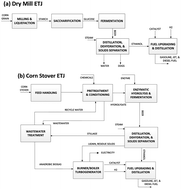Techno-economic analysis for upgrading the biomass-derived ethanol-to-jet blendstocks
Abstract
This study summarizes the detailed techno-economic analysis of the ethanol-to-jet (ETJ) process based on two different feedstocks (corn grain and corn stover) at the plant scale of 2000 dry metric tons per day. Ethanol biologically derived from biomass is upgraded catalytically to jet blendstocks via alcohol dehydration, olefin oligomerization, and hydrotreating. In both pathways, corn-grain-derived ethanol to jet (corn mill ETJ) and corn-stover-derived ethanol to jet (corn stover ETJ), there are portions of gasoline and diesel produced as coproducts. Two cost bases are used in this study: the minimum jet fuel selling prices (MJSP) for jet-range blendstocks and the minimum fuel selling prices (MFSP) for all the hydrocarbons (gasoline, jet, and diesel) produced using a gallon gasoline equivalent (GGE) basis. The nth-plant MJSPs for the two pathways are estimated to be $4.20 per gal for corn mill and $6.14 per gal for corn stover, while MFSPs are $3.91 per GGE for corn mill and $5.37 per GGE for corn stover. If all of the hydrocarbon products (gasoline, jet, and diesel ranges) can be considered as fuel blendstocks using a GGE basis, the total hydrocarbon yield for fuel blendstock is 49.6 GGE per dry ton biomass for corn stover and 71.0 GGE per dry ton biomass for corn grain. The outcome of this study shows that the renewable jet fuel could be cost competitive with fossil derived jet fuel if further improvements could be made to increase process yields (particularly yields of sugars, sugar to ethanol, and ethanol to hydrocarbons), research and development of sustainable feedstocks, and more effective catalytic reaction kinetics. Pioneer plant analysis, which considers the increased capital investment and the decreased plant performance over the nth-plant analysis, is also performed, showing a potential 31%–178% increase in cost compared to the nth-plant assumptions for the dry mill pathway, but with a much wider range of 69%–471% cost increase over the nth-plant assumptions for the corn stover pathway. While there are large differences between the estimated first of a kind plant cost and the targeted nth-plant case, reduction of costs is possible through improvement of the overall process efficiency, yields, reduction in overall capital, co-product revenues and strategically improve performance by process learnings.



 Please wait while we load your content...
Please wait while we load your content...